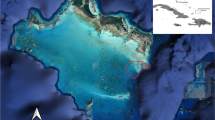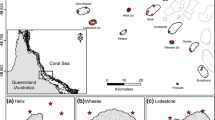Abstract
Despite being a common apex-level predator on coral reefs throughout the tropical Indo-Pacific, surprisingly little is known about whitetip reef shark (Triaenodon obesus) movements and biology. This study used photo-identification from community-contributed photographs to reveal patterns in movements, reproductive biology, and fisheries interactions in this species that have not been previously revealed through more traditional methods. At least 178 individual sharks were identified, and 26 movements were observed. These included movement distances of up to 26.4 km, movement rates of up to 3.27 km/day (9.8 km in 3 days), and movements that required the transit of a 140 m deep channel. Other animals showed high philopatry, being re-sighted at the same locality on multiple occasions (up to 13 sightings for one individual) over periods of up to 7 years. Females showed higher philopatry than males and were more likely than males to be found at shallow (<10 m depth) localities throughout the year. The proportion of male sightings at shallow localities was significantly higher in April and May than other months of the year, possibly due to males coming into the shallows to mate with females. A peak in sightings of late-term females followed by an abrupt decline suggests that pupping season is May into early June, and two females were observed pregnant in consecutive years despite evidence that the gestation period is approximately 1 year for this species. Nine percent of animals carried fishing tackle or exhibited jaw injuries associated with fishery interactions, with multiple individuals found dead after being hooked by fishers.










Similar content being viewed by others

References
Arzoumanian Z, Holmberg J, Norman B (2005) An astronomical pattern-matching algorithm for computer-aided identification of whale sharks Rhincodon typus. J Appl Ecol 42:999–1011
Bansemer, CS, Bennett MB (2008) Multi-year validation of photographic identification of grey nurse sharks, Carcharias taurus, and applications for non-invasive conservation research. Marine and Freshwater Research 59:322–331
Barker SM, Williamson JE (2010) Collaborative photo-identification and monitoring of grey nurse sharks (Carcharias taurus) at key aggregation sites along the eastern coast of Australia. Mar Freshw Res 61:971–979
Bascompte J, Melian CJ, Sala E (2005) Interaction strength combinations and the overfishing of a marine food web. Proc Natl Acad Sci USA 102:5443–5447
Bowler DE, TG Benton (2005) Causes and consequences of animal dispersal strategies: relating individual behaviour to spatial dynamics. Cambridge Univ Press, pp 205–225
Brown JS, Laundré JW, Gurung M (1999) The ecology of fear: optimal foraging, game theory, and trophic interactions. JSTOR, pp 385–399
Campana SE, Joyce W, Manning MJ (2009) Bycatch and discard mortality in commercially caught blue sharks Prionace glauca assessed using archival satellite pop-up tags. Mar Ecol Prog Ser 387:241–253
Carrier JC, Pratt HL Jr, Martin LK (1994) Group reproductive behaviour in free-living nurse sharks, Ginglymostoma cirratum. Copeia : 646–656
Castro ALF, Rosa RS (2005) Use of natural marks on population estimates of the nurse shark, Ginglymostoma cirratum, at Atol das Rocas Biological Reserve, Brazil. Environ Biol Fishes 72:213–221
Compagno L, Dando M, Fowler S (2005) Sharks of the world. Princeton University Press, Princeton, p 368
Cortes E (1999) Standardized diet compositions and trophic levels of sharks. ICES J Mar Sci 56:707–717
Domeier ML, Nasby-Lucas N (2007) Annual re-sightings of photographically identified white sharks (Carcharodon carcharias) at an eastern Pacific aggregation site (Guadalupe Island, Mexico). Springer, pp 977–984
Economakis AE, Lobel PS (1998) Aggregation behavior of the grey reef shark, Carcharhinus amblyrhynchos, at Johnston Atoll, Central Pacific Ocean. Environ Biol Fishes 51:129–139
Ferretti F, Worm B, Britten GL, Heithaus MR, Lotze HK (2010) Patterns and ecosystem consequences of shark declines in the ocean. Ecol Lett 13(8):1055–1107
Friedlander AM, DeMartini EE (2002) Contrasts in density, size, and biomass of reef fishes between the northwestern and the main Hawaiian islands: the effects of fishing down apex predators. Mar Ecol Prog Ser 230:253–265
Gruber SH, Nelson DR, Morrissey JF (1988) Patterns of activity and space utilization of lemon sharks, Negaprion brevirostris, in a shallow Bahamian lagoon. Bull Mar Sci 43:61–76
Holmberg J, Norman B, Arzoumanian Z (2008) Robust, comparable population metrics through collaborative photo-monitoring of whale sharks Rhincodon typus. Eco Soc Am pp 222–233
Holmberg J, Norman B, Arzoumanian Z (2009) Estimating population size, structure, and residency time for whale sharks Rhincodon typus through collaborative photo-identification. Endanger Species Res 7:39–53
Huveneers C, Luo K, Otway NM, Harcourt RG (2009) Assessing the distribution and relative abundance of wobbegong sharks (Orectolobidae) in New South Wales, Australia, using recreational scuba-divers. Aquat Living Resour 22:255–264
Kajiura SM, Sebastian AP, Tricas TC (2000) Dermal bite wounds as indicators of reproductive seasonality and behavior in the Atlantic stingray, Dasyatis sabina. Environ Biol Fishes 58:23–31
Marshall AD, Bennett MB (2010) Reproductive ecology of the reef manta ray Manta alfredi in Southern Mozambique. J Fish Biol 77:169–190
McKibben JR, Nelson DR (1986) Patterns of movements and grouping of grey reef sharks, Carcharhinus amblyrhynchos, at Enewetak, Marshal Islands. Bull Mar Sci 38:89–110
Meekan MG, Bradshaw CJA, Press M, McLean C, Richards A, Quasnichka S, Taylor JG (2006) Population size and structure of whale sharks Rhincodon typus at Ningaloo Reef, Western Australia. Mar Ecol Prog Ser 319:275–285
Meyer CG, Clark TB, Papastamatiou YP, Whitney NM, Holland KN (2009) Long-term movement patterns of tiger sharks Galeocerdo cuvier in Hawaii. Mar Ecol Prog Ser 381:223–235
Nelson DR, Johnson RH (1980) Behavior of the reef sharks of Rangiroa, French Polynesia. Natl Geogr Soc Res Rep 12:479–499
Ott L, Larson RF, Mendenhall W (1987) Statistics: a tool for the social sciences. Duxbury Press, Pacific Grove, p 576
Papastamatiou YP, Lowe CG, Caselle JE, Friedlander AM (2009) Scale-dependent effects of habitat on movements and path structure of reef sharks at a predator-dominated atoll. Ecology 90:996–1008
Porcher IF (2005) On the gestation period of the blackfin reef shark, Carcharhinus melanopterus, in waters off Moorea, French Polynesia. Mar Biol 146:1207–1211
Pratt HL Jr, Carrier JC (2001) A review of elasmobranch reproductive behavior with a case study on the nurse shark, Ginglymostoma cirratum. Environ Biol Fishes 60:157–188
Pratt HL Jr, Carrier JC (2005) Elasmobranch courtship and mating behavior. In: Hamlett WC (ed) Reproductive behavior and phylogeny of elasmobranchs. Science Publishers, Enfield, pp 129–169
Randall JE (1977) Contribution to the biology of the whitetip reef shark (Triaenodon obesus). Pac Sci 31:143–164
Robbins WD (2006) Abundance, demography, and population structure of the grey reef shark (Carcharhinus amblyrhynchos) and the whitetip reef sharks (Triaenodon obesus) (Fam. Carcharhinidae). James Cook University, Townsville, p 214
Robbins WD, Hisano M, Connolly SR, Choat JH (2006) Ongoing collapse of coral-reef shark populations. Curr Biol 16:2314–2319
Sandin SA, Smith JE, DeMartini EE, Dinsdale EA, Donner SD, Friedlander AM, Konotchick T, Malay M, Maragos JE, Obura D (2008) Baselines and degradation of coral reefs in the northern Line Islands, Public Library of Science
Schaller P (2006) Husbandry and reproduction of whitetip reef sharks, Triaenodon obesus, at Steinhart Aquarium, San Francisco. Int Zoo Yearb 40:232–240
Skomal G, Bernal D (2009) Physiological responses to stress in sharks. In: Carrier JC, Heithaus LI, Musick JA (eds) Sharks and their relatives II. CRC Press, Boca Raton, p 713
Taniuchi T (1975) Reef whitetip shark, Triaenodon obesus, from Japan. Jpn J Ichthyol 22:167–170
Taylor LC (1993) Sharks of Hawaii: their biology and cultural significance. University of Hawaii Press, Honolulu, p 126
Tester AL (1969) Cooperative shark research and control program final report, 1967–1969. University of Hawaii, Honolulu
Tricas TC, LeFeuvre EM (1985) Mating in the reef white-tip shark, Triaenodon obesus. Mar Biol 84:233–237
Uchida S, Toda M, Kamei Y (1990) Reproduction of elasmobranchs in captivity. In: Pratt HL Jr, Gruber SH, Taniuchi T (eds) Elasmobranchs as living resources: advances in biology, ecology, systematics and status of the fisheries. NOAA Tech. Rep. NMFS 90. pp 211–237
Van Tienhoven AM, Den Hartog JE, Reijns RA, Peddemors VM (2007) A computer-aided program for pattern-matching of natural marks on the spotted raggedtooth shark Carcharias taurus. J Appl Ecol 44:273–280
Whitney NM, Pratt HL Jr, Carrier JC (2004) Group courtship, mating behaviour, and siphon sac function in the whitetip reef shark, Triaenodon obesus. Anim Behav 68:1435–1442
Whitney NM, Papastamatiou YP, Holland KN, Lowe CG (2007) Use of an acceleration data logger to measure diel activity patterns in captive whitetip reef sharks, Triaenodon obesus. Aquat Living Resour 20:299–305
Wourms JP (1977) Reproduction and development in chondrichthyan fishes. Am Zool 17:379–410
Acknowledgements
We thank the 90 photographers who contributed shark images for our analyses (please see full list at www.whitetip.org/Acknowledgements.htm), particularly A. Chadwick, B. Groark, C. Hankins, G. Poulain, B. Stohler, and D. Wescott for allowing their images to be used in the figures above. Great thanks to numerous individuals who helped with fieldwork, including: K. O’Brien, J. Johnson, M. Hoesterey, A. Schwanke, P. Fienne, S. Foulger, J. and V. Young, T. TinHan, J. Milisen, J. Dale, and numerous others. Photo-matching efforts benefited greatly from the help of J. Stuart, K. Hurd, T. TinHan, and J. Milisen. S. Liden designed the photo-contribution website and A. McClung and J. Dale provided statistical advice and comments on an early version of the manuscript. This project was funded by grants to NMW from the National Science Foundation (Graduate Research Fellowship #200307790), Budweiser/National Fish and Wildlife Conservation Scholarship program, PADI Project AWARE, American Museum of Natural History Lerner-Gray grant, the University of Hawaii Arts and Sciences Advisory Council, Sigma Xi, the Pritzker Foundation, and Mote Marine Laboratory.
Author information
Authors and Affiliations
Corresponding author
Rights and permissions
About this article
Cite this article
Whitney, N.M., Pyle, R.L., Holland, K.N. et al. Movements, reproductive seasonality, and fisheries interactions in the whitetip reef shark (Triaenodon obesus) from community-contributed photographs. Environ Biol Fish 93, 121–136 (2012). https://doi.org/10.1007/s10641-011-9897-9
Received:
Accepted:
Published:
Issue Date:
DOI: https://doi.org/10.1007/s10641-011-9897-9



